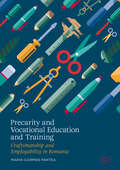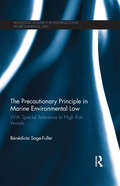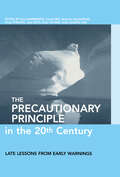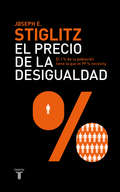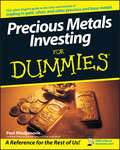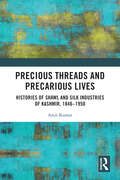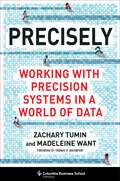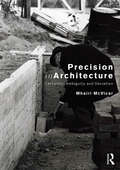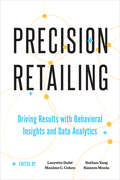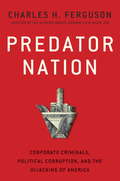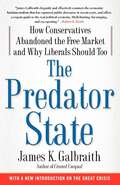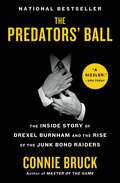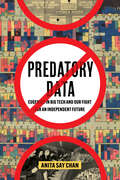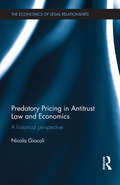- Table View
- List View
Precarity and Vocational Education and Training: Craftsmanship and Employability in Romania
by Maria-Carmen PanteaThis book explores how the changing nature of work intersects with and influences young people’s views on their future. As an increasingly precarious service sector overtakes traditional industrial work, vocational education and training (VET) is held up as a panacea for poverty alleviation, youth unemployment and economic growth. However, the views of young people in VET themselves concerning their own work and aspirations have largely been ignored. Based on interviews and focus groups conducted with over 250 young people in VET in Romania, this book examines the types of subjectivities that are generated in the processes by which they try to make sense of future and the meanings of work. In doing so, the author identifies three ideological layers that frame their views: arguing that while the young people interviewed hold ‘conventional’ aspirations for stability and predictability; they were visibly influenced by neoliberal beliefs in agency, experimentation and short termism. Ultimately, a layer of low expectations crystallises unvoiced concerns over a troubling future. In highlighting young people’s voices, this pioneering book calls for a recalibration of the emphasis on VET in Romania. It will appeal to students and scholars of youth studies, the sociology of work, vocational education and training and European studies.
The Precautionary Principle in Marine Environmental Law: With Special Reference to High Risk Vessels (Routledge Research in International Environmental Law)
by Bénédicte Sage-FullerThe book examines whether the jurisdiction of coastal States under international law can be extended to include powers of intervention towards vessels posing a significant risk to their coastal and marine environment, but which have not yet been involved in any incident or accident. The books sets out how it is that coastal State jurisdiction can indeed be seen as including powers of intervention towards High Risks Vessels before an incident or accident happens, on the basis of the precautionary principle. The precautionary principle requires taking action when a risk of damage to the environment is suspected, but cannot be confirmed scientifically.The book thus considers the potential opportunities for the coastal state under international law to regulate international shipping where they consider vessels to an unacceptable risk to the environment, in order to prevent or minimise the risk of occurrence of the accident or incident leading to damage. The book acknowledges that this puts into question some very old and established principles of the law of the sea, most importantly the principle of freedom of navigation. But Bénédicte Sage-Fuller contends that this change would itself be a consequence of the evolution, since the end of WWII, of on the one hand international law of the sea itself, and of international environmental law on the other hand.
The Precautionary Principle in the 20th Century: Late Lessons from Early Warnings
by David Gee Brian Wynne Sofia Guedes Vaz Poul Harremoës Malcolm MacGarvin Andy Stirling Jane KeysThe precautionary principle is widely seen as fundamental to successful policies for sustainability. It has been cited in international courts and trade disputes between the USA and the EU, and invoked in a growing range of political debates. Understanding what it can and cannot achieve is therefore crucial. This volume looks back over the last century to examine the role the principle played or could have played, in a range of major and avoidable public disasters. From detailed investigation of how each disaster unfolded, what the impacts were and what measures were adopted, the authors draw lessons and establish criteria that could help to minimise the health and environmental risks of future technological, economic and policy innovations. This is an informative resource for all those from lawyers and policy-makers, to researchers and students needing to understand or apply the principle.
El precio de la desigualdad: El 1 % de población tiene lo que el 99 % necesita
by Joseph E. StiglitzUn argumento contundente contra una sociedad en desequilibrio de la mano del premio Nobel de Economía Joseph Stiglitz. Esta edición incluye nuevo prólogo actualizado del autor. El 1 % de la población disfruta de las mejores viviendas, la mejor educación, los mejores médicos y el mejor nivel de vida, pero hay una cosa que el dinero no puede comprar: la comprensión de que su destino está ligado a cómo vive el otro 99 %. A lo largo de la historia esto es algo que esa minoría solo ha logrado entender, cuando ya era demasiado tarde. Las consecuencias de la desigualdad son conocidas: altos índices de criminalidad, problemas sanitarios, menores niveles de educación, de cohesión social y de esperanza de vida. Pero ¿cuáles son sus causas, por qué está creciendo con tanta rapidez y cuál es su efecto sobre la economía? El precio de la desigualdad proporciona las esperadas respuestas a estasapremiantes cuestiones en una de las más brillantes contribuciones de un economista al debate público de los últimos años. El premio Nobel Joseph Stiglitz muestra cómo los mercados por sí solos no son ni eficientes ni estables y tienden a acumular la riqueza en manos de unos pocos más que a promover la competencia. Revela además cómo las políticas de gobiernos e instituciones son propensas a acentuar esta tendencia, influyendo sobre los mercados en modos que dan ventaja a los más ricos frente al resto. La democracia y el imperio de la ley se ven a su vez debilitados por la cada vez mayor concentración del poder en manos de los más privilegiados. Este libro constituye una contundente crítica a las ideas del libre mercado y a la dirección que Estados Unidos y muchas otras sociedades han tomado durante los últimos treinta años, demostrando por qué no es solo injusta sino además insensata. Stiglitz ofrece esperanza en la forma de un concreto conjunto de reformas que contribuirían a crear una sociedad más justa y equitativa, además de una economía más sólida y estable. Reseñas:«El libro es un modelo de claridad, pero esa es solo una de sus virtudes. Otra es cómo Stiglitz enmarca el problema; no parte del lugar de la "enorme desigualdad es un hecho de la vida en nuestro sistema de libre mercado, y así es como debe ser". Parte de un lugar mucho más interesante, franco y humano: "Esto está ocurriendo. ¿Por qué? ¿Está funcionando el mercado sin complicaciones o alguien se está aprovechando de su poder? Y por encima de todo, ¿está la sociedad mejor o peor?"»Rolling Stone «El precio de la desigualdad es una poderosa súplica para la puesta en práctica de lo que Alexis de Tocqueville denominó "interés propio bien entendido".»The Guardian «El precio de la desigualdad pone de manifiesto el don de Stiglitz para interpretar y exponer los temas complejos de la economía con un escritura accesible a un público no especializado y amplio.»NewStatesman «A esa rabia algunas veces incoherente, que se ha visto en Occupy Wall Street y en los "indignados" de España, Stiglitz le da forma, contenido, fluidez y autoridad.»The Guardian «Un libro glorioso.»Joaquín Estefanía, El País
Precious Metals Investing For Dummies
by Paul MladjenovicIn recent years, metals have been among the safest and most lucrative investments around, but they are not entirely risk free. Before you begin investing or trading in metals, you need authoritative information and proven investment strategies. You need Precious Metal Investing For Dummies.This straightforward guide eases you into the precious metals market with sound advice on trading and owning these profitable investments, including gold, silver, platinum, and uranium, as well as high-demand base metals such as zinc and copper. You'll learn how to research their market performance and choose among an array of proven trading plans and strategies. Plus, you'll get savvy advice on how to choose a broker, buy stocks and futures that involve metals, maximize your investment return, and minimize your risk. Discover how to:Evaluate the different metalsAdd metals to your portfolioDecide whether you're an investor or a traderIdentify your metal-investment goalsWeigh the risks and benefits of metals investingBuy physical metalsUse technical analysis to evaluate opportunitiesMake long-term investments in precious metalsDiversify your metals investmentsAnalyze base-metals companiesPurchase numismatic coinsAdd metals to your mutual fund or ETF portfolioUnderstand how politics effects metals pricesMetals can be an important and valuable addition to any investment portfolio or retirement plan. Make the most out of your investment with Precious Metal Investing For Dummies.
Precious Threads and Precarious Lives: Histories of Shawl and Silk Industries of Kashmir, 1846–1950
by Amit KumarThis book studies the hitherto unexplored history of the shawl and silk industries of the himalyan state of Jammu and Kashmir, India. It focuses on the three processes – production, circulation, and consumption – of the textile industry of the region to highlight its socio-economic and political importance in 19th- and 20th-century Kashmir. Using the micro-history approach, it studies the sites of production – the home looms or the small karkhana – efficiency of labour, and innovations by weavers in their techniques to suit the demands of the market. It also locates the impact colonialism had on transforming the labour economy in the Kashmir textile industry. Further, it compares these karkhanas with the Scottish factories or home looms to illuminate many sites of difference and comparison between the working styles and technologies. Mapping a history as complex as the weave on the finest Kashmiri shawl, this book brings to life the interface between culture, commodity, and colonial networks. It will be of great interest to scholars and researchers of South Asian history, colonial and imperial history, cultural studies, and economic and labour history.
Precise Software
by Sara Bergson Paul A. GompersYossi Sela, general partner at Gemini Venture capital, considers a new investment in Precise Software. The firm is at a crisis point, and Sela needs to decide whether he will fire the firm's chief executive officer. Conflicts between the American CEO and the Israeli founders of the firm are hampering the company.
Precise Software Solutions
by David B. GodesWhen and how should a firm introduce an innovative new product? Introduce too early and functionality may not be there, too late and strong competition might appear. Precise Software Solutions, headquartered in Westwood, MA, is a small, growing company with a successful--albeit narrowly targeted--software product for database performance management. In 1999, it had the beginnings of a new product with radically broader functionality and market appeal. However, this new product would potentially appeal to a different "audience" within the client's IT organization. Once management decides when to introduce the product, it must also decide how to do so. Specifically, should this product be sold through the same sales force as other successful products? Or, would the company be better off creating a separate group targeted at this new audience? Finally, it must also decide how to price the product. Its current products have historically yielded sales of $15K to $25K. The firm feels that the value of this new product could be five times this amount. Is this possible? Will the same salespeople be effective? Teaching Purpose: Examines sales organization, sales strategy, and new product introduction.
Precisely: Working with Precision Systems in a World of Data
by Zachary Tumin Madeleine WantIf you want to win an election, improve the health of a city, or thrill your customers, you’re going to need precision systems—the highly engineered working arrangements of teams, processes, and technologies that put data and AI to work creating the change that leaders want, exactly how they want it. Big Tech firms like Amazon, Google, Apple, and Facebook have mastered their own precision systems, building trillion-dollar businesses using data-driven tools from mass-market “nudges” to industrial-grade recommendation systems.Precisely is the playbook for the rest of us. Zachary Tumin and Madeleine Want show how leaders in every domain are taking real-time precision systems into the marketplace, the political race, and the fight for health—from New York-Presbyterian Hospital to the New York Times, the NFL’s Baltimore Ravens to BNSF Railroad, the Biden-Harris campaign to the NYPD—to reveal elusive patterns, perform a repetitive task, run a play, or tailor a message, one at a time or by the millions.Precisely provides insight that will help leaders choose the system that’s right for them, decide which problem to tackle first, sell the importance of precision to stakeholders, power-up the people and the technology, and accomplish change that delivers precisely what’s needed every time—and do it all responsibly.
Precision in Architecture: Certainty, Ambiguity and Deviation
by Mhairi McVicarThis book offers a detailed insight into the desire for, and consequences of, precise communications in the daily life of contemporary architectural practice through close readings of constructed architectural details by Sigurd Lewerentz, Caruso St John Architects, Mies van der Rohe and OMA. In the professionalised context of the contemporary architectural profession, precise communications – drawings, specifications, letters, faxes and emails – are charged with the complex task of translating architectural intent into a neutral and quantifiable language which is expected to guarantee an exact match between the architects’ intentions and the constructed result. Yet, as any architectural practitioner will know, it is doubtful whether the construction of any architectural project may ever exactly match all written and drawn predictions. This book challenges claims to certainty which have been attributed to such communications from the mid-nineteenth century onwards, and critiques ongoing expectations of certainty in contemporary architectural production.
Precision Oncology and Cancer Biomarkers: Issues at Stake and Matters of Concern (Human Perspectives in Health Sciences and Technology #5)
by Roger Strand Anne BremerThis open access book reflects on matters of social and ethical concern raised in the daily practices of those working in and around precision oncology. Each chapter addresses the experiences, concerns and issues at stake for people who work in settings where precision oncology is practiced, enacted, imagined or discussed. It subsequently discusses and analyses bioethical dilemmas, scientific challenges and economic trade-offs, the need for new policies, further technological innovation, social work, as well as phenomenological research. This volume takes a broad actor-centred perspective as, whenever cancer is present, the range of actors with issues at stake appears almost unlimited. This perspective and approach opens up the possibility for further in-depth and diverse questions, posed by the actors themselves, such as: How are cancer researchers navigating biological uncertainties? How do clinicians and policy-makers address ethical dilemmas around prioritisation of care? What are the patients’ experiences with, and hopes for, precision oncology? How do policy-makers and entrepreneurs envisage precision oncology? These questions are of great interest to a broad audience, including cancer researchers, oncologists, policy-makers, medical ethicists and philosophers, social scientists, patients and health economists.
Precision Paint Co.
by Chiara Farronato Iavor Bojinov Janice H. Hammond Michael Parzen Paul J. HamiltonDescribes a marketing director about to launch a new process for demand forecasting. Provides data that allow students to do a multivariable regression analysis. A rewritten version of an earlier case.
Precision Parts, Inc. (A)
by William A. Sahlman Helen M. SoussouContains a description of a decision confronting two entrepreneurs in mid-1981. They are considering purchasing a small manufacturer of precision electromechanical parts. Among the issues in the case are the following: 1) Should Taylor and Grayson buy Precision Parts, Inc.? 2) Should Shawmut Bank provide the loan? 3) Should the venture capital firms invest? 4) What should Taylor and Grayson do? The case is designed to expose students to a different kind of opportunity. Also, students will have to ask and answer the questions: What can go wrong and what can go right? They must develop a plan for managing the risk-reward ratio in their favor.
Precision Retailing: Driving Results with Behavioral Insights and Data Analytics (Behaviorally Informed Organizations)
by Laurette Dubé Maxime C. Cohen Nathan Yang Bassem MonlaWithout a doubt, the COVID-19 era has forced the retail sector to rethink the way it conducts business. Customer experience has largely shifted into the digital realm, and questions have emerged about how to best optimize and evolve business operations in light of this change. Drawing on a host of expert contributors, Precision Retailing takes a broad perspective on precision retailing as the interaction point between individuals and the organizations, institutions, systems, and policies that support them in ever-changing contexts. The book assembles precision retailing key concepts, methods, and tools that complement existing behavioral research. The decision support tools will help managers better capture in real time the multiscale drivers of consumer behavior and successfully integrate these into their retail strategy and tactics. Each chapter includes a short strategic brief for successful human-centered digital transformation that focuses squarely on actionable insights for practitioners. Shedding light on the way we understand and handle this complex customer journey, Precision Retailing examines how retail will evolve in the post-COVID era, shaping how businesses meet the inevitable continuation of the digital transition.
Precision Worldwide, Inc.
by William J. Bruns Jr.A competitor has developed and introduced a superior product that is less costly to manufacture. Precision Worldwide must decide whether to match the competitor's product, when to do so, and how to price, given that it holds a large inventory of its now inferior product.
Precista Tools AG (A)
by Louis B. BarnesA young woman manager in a Swiss family firm finds that her role as a managing director becomes bitterly unpleasant once her older brother decides to leave an engineering career and join the family business. That is what the father, who was head of the business had been hoping and waiting for. He begins to belittle and ridicule the daughter. The board of directors also favors a male successor. The daughter writes a letter of resignation just before taking a trip abroad. While she is overseas, both parents write letters asking her to reconsider.
Precista Tools AG (B)
by Louis B. BarnesThe family holds a meeting to talk about the future of the business. Designed to be used with Precista Tools AG (A) and (C) in a one class period.
Precista Tools AG (C)
by Louis B. BarnesDesigned to be used with Precista Tools AG (A) and (B) in one class period.
Precursors to Innovation
by Joseph V. Sinfield Scott D. Anthony Mark W. Johnson Elizabeth J. AltmanBefore turning to individual innovation initiatives or innovation-specific structures, companies need to make sure they have the appropriate precursors for innovation. This chapter describes three critical precursors: a core business that is in control, a game plan for growth, and mastery of the resource allocation process.
Predator Nation: Corporate Criminals, Political Corruption, and the Hijacking of America
by Charles H. FergusonCharles H. Ferguson, who electrified the world with his Oscar-winning documentary Inside Job, now explains how a predator elite took over the country, step by step, and he exposes the networks of academic, financial, and political influence, in all recent administrations, that prepared the predators' path to conquest. Over the last several decades, the United States has undergone one of the most radical social and economic transformations in its history. · Finance has become America's dominant industry, while manufacturing, even for high technology industries, has nearly disappeared. · The financial sector has become increasingly criminalized, with the widespread fraud that caused the housing bubble going completely unpunished. · Federal tax collections as a share of GDP are at their lowest level in sixty years, with the wealthy and highly profitable corporations enjoying the greatest tax reductions. · Most shockingly, the United States, so long the beacon of opportunity for the ambitious poor, has become one of the world's most unequal and unfair societies. If you're smart and a hard worker, but your parents aren't rich, you're now better off being born in Munich, Germany or in Singapore than in Cleveland, Ohio or New York. This radical shift did not happen by accident. Ferguson shows how, since the Reagan administration in the 1980s, both major political parties have become captives of the moneyed elite. It was the Clinton administration that dismantled the regulatory controls that protected the average citizen from avaricious financiers. It was the Bush team that destroyed the federal revenue base with its grotesquely skewed tax cuts for the rich. And it is the Obama White House that has allowed financial criminals to continue to operate unchecked, even after supposed "reforms" installed after the collapse of 2008. Predator Nation reveals how once-revered figures like Alan Greenspan and Larry Summers became mere courtiers to the elite. Based on many newly released court filings, it details the extent of the crimes--there is no other word--committed in the frenzied chase for wealth that caused the financial crisis. And, finally, it lays out a plan of action for how we might take back our country and the American dream.
The Predator State: How Conservatives Abandoned the Free Market and Why Liberals Should Too
by James K. GalbraithThe cult of the free market has dominated economic policy-talk since the Reagan revolution of nearly thirty years ago. Tax cuts and small government, monetarism, balanced budgets, deregulation, and free trade are the core elements of this dogma, a dogma so successful that even many liberals accept it. But a funny thing happened on the bridge to the twenty-first century. While liberals continue to bow before the free-market altar, conservatives in the style of George W. Bush have abandoned it altogether. That is why principled conservatives -- the Reagan true believers -- long ago abandoned Bush. Enter James K. Galbraith, the iconoclastic economist. In this riveting book, Galbraith first dissects the stale remains of Reaganism and shows how Bush and company had no choice except to dump them into the trash. He then explores the true nature of the Bush regime: a "corporate republic," bringing the methods and mentality of big business to public life; a coalition of lobbies, doing the bidding of clients in the oil, mining, military, pharmaceutical, agribusiness, insurance, and media industries; and a predator state, intent not on reducing government but rather on diverting public cash into private hands. In plain English, the Republican Party has been hijacked by political leaders who long since stopped caring if reality conformed to their message. Galbraith follows with an impertinent question: if conservatives no longer take free markets seriously, why should liberals? Why keep liberal thought in the straitjacket of pay-as-you-go, of assigning inflation control to the Federal Reserve, of attempting to "make markets work"? Why not build a new economic policy based on what is really happening in this country? The real economy is not a free-market economy. It is a complex combination of private and public institutions, including Social Security, Medicare and Medicaid, higher education, the housing finance system, and a vast federal research establishment. The real problems and challenges -- inequality, climate change, the infrastructure deficit, the subprime crisis, and the future of the dollar -- are problems that cannot be solved by incantations about the market. They will be solved only with planning, with standards and other policies that transcend and even transform markets. A timely, provocative work whose message will endure beyond this election season, The Predator State will appeal to the broad audience of thoughtful Americans who wish to understand the forces at work in our economy and culture and who seek to live in a nation that is both prosperous and progressive.
Predators and Prey: A New Ecology of Competition
by James F. MooreThe author sets up a new metaphor for competition drawn from the study of biology and social systems. He suggests that a company be viewed not as a member of a single industry but as part of a business ecosystem that crosses a variety of industries. In a business ecosystem, companies "co-evolve" around a new innovation, working cooperatively and competitively to support new products and satisfy customer needs. In a large business environment, several ecosystems may vie for survival and dominance. In fact, it's largely competition among business ecosystems, not individual companies, that's fueling today's industrial transformation. Managers can't afford to ignore the birth of new ecosystems or the competition among those that already exist. McKinsey Award Winner.
Predator's Ball: The Inside Story of Drexel Burnham and the Rise of the Junk Bond Raiders
by Connie BruckDuring the '80s, Michael Milken at Drexel Burnham created the corporate raiders. He was the billionaire Junk Bond King. But, in the corner stood the U.S. District Attorney waiting to file criminal and racketeering charges.
Predatory Data: Eugenics in Big Tech and Our Fight for an Independent Future
by Anita Say ChanThe first book to draw a direct line between the datafication and prediction techniques of past eugenicists and today's often violent and extractive "big data" regimes. Predatory Data illuminates the throughline between the nineteenth century's anti-immigration and eugenics movements and our sprawling systems of techno-surveillance and algorithmic discrimination. With this book, Anita Say Chan offers a historical, globally multisited analysis of the relations of dispossession, misrecognition, and segregation expanded by dominant knowledge institutions in the Age of Big Data. While technological advancement has a tendency to feel inevitable, it always has a history, including efforts to chart a path for alternative futures and the important parallel story of defiant refusal and liberatory activism. Chan explores how more than a century ago, feminist, immigrant, and other minoritized actors refused dominant institutional research norms and worked to develop alternative data practices whose methods and traditions continue to reverberate through global justice-based data initiatives today. Looking to the past to shape our future, this book charts a path for an alternative historical consciousness grounded in the pursuit of global justice. A free ebook version of this title is available through Luminos, University of California Press’s Open Access publishing program. Visit www.luminosoa.org to learn more.
Predatory Pricing in Antitrust Law and Economics: A Historical Perspective (The Economics of Legal Relationships)
by Nicola GiocoliCan a price ever be too low? Can competition ever be ruinous? Questions like these have always accompanied American antitrust law. They testify to the difficulty of antitrust enforcement, of protecting competition without protecting competitors. As the business practice that most directly raises these kinds of questions, predatory pricing is at the core of antitrust debates. The history of its law and economics offers a privileged standpoint for assessing the broader development of antitrust, its past, present and future. In contrast to existing literature, this book adopts the perspective of the history of economic thought to tell this history, covering a period from the late 1880s to present times. The image of a big firm, such as Rockefeller’s Standard Oil or Duke’s American Tobacco, crushing its small rivals by underselling them is iconic in American antitrust culture. It is no surprise that the most brilliant legal and economic minds of the last 130 years have been engaged in solving the predatory pricing puzzle. The book shows economic theories that build rigorous stories explaining when predatory pricing may be rational, what welfare harm it may cause and how the law may fight it. Among these narratives, a special place belongs to the Chicago story, according to which predatory pricing is never profitable and every low price is always a good price.
